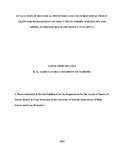| dc.description.abstract | French bean, Phaseolus vulgaris L. is an important crop in Kenya mainly grown by small holder
farmers in various parts of the country. However, farmers face many challenges among them
pests and diseases.
The objective of the study was to evaluate the effectiveness of the botanical pesticides Tithonia
(Tithonia diversifolia), Tephrosia (Tephrosia vogelii), Tagetes (Tagetes minuta) and Spider plant
(Gynandropsis gynandra) extracts were used and coloured sticky traps, blue, yellow and clear to
control insect pests of French bean: thrips (Megalurothrips sjostedti Trybom, Frankliniella
occidentalis Pergade, Frankliniella schultzei Trybom, bean aphid (Aphis fabae Scopoli)) and
whiteflies (Bemisia tabaci). The experiment was laid out in a randomized complete block design
(RCBD) replicated three times. The treatment application was done once a week to control
thrips, whiteflies and aphids and the experiments were carried out in relay for three crop cycles.
The botanical pesticides were prepared from dried powdered leaves of Tithonia, Tephrosia,
Tagetes and Spider plant which were infused in hot water for twelve hours and then sieved using
muslin cloth. The extracts were sprayed on the French beans on a weekly basis. All the plant
extracts were compared with a synthetic pyrethroid (Decis) and a commercial pesticide derived
from neem product (Nimbecidine). In another experiment sticky colored traps blue, yellow and
clear were used for controlling aphids, thrips and whiteflies . The traps were mounted in the in
the middle of the plots 60 cm above the ground just before flowering. The traps were placed
weekly and assessment done for four weeks. The yields of French beans were recorded for each
planting.
Data was collected on a weekly basis where thrips population was assessed from 5 flowers per
plant on 5 plants randomly selected in the middle of each plot. The aphids and white flies were
assessed in the same manner but from 3 leaves and 3 plants.
All the plant extracts were effective in controlling the insect pests. Tephrosia was more effective
than the other extracts (p<0.05). However, there was no significant difference between by
Tephrosia and Tithonia treatments in reducing pest numbers. The two botanical pesticides
Tithonia (Tithonia diversifolia) and Tephrosia (Tephrosia vogelii) activity on aphids, thrips and
whiteflies was comparable to that of commercial pesticides (Decis and Nimbecidine) in reducing
pest population densities and damage caused by the target insect pests. The blue and yellow traps
were significantly (p<0.05) more effective than the clear traps in reducing target pests. The
chemical (Decis) treatment was superior and significantly different from the traps (p<0.05), as
was expected.
The study demonstrated that botanical pesticides and sticky colored traps have a role to play in
the management of insect pests (aphids, whiteflies and thrips) in French beans and can be used in
an integrated pest management strategy to reduce pesticide use in small scale farmers’ fields.
Botanical pesticides can be a sustainable alternative to synthetic pesticides for controlling pests
and diseases. Coloured sticky insect traps are usually used to monitor pests but can also be used
to mass trap insects and reduce the rate of increase of pests. | en_US |

